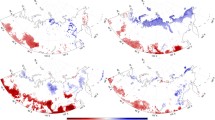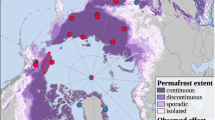Abstract
While most Arctic amplification research is focused on sea ice reduction and its feedbacks onto the climate system, the impacts of permafrost degradation in high latitudes and subsequent land–atmosphere interactions potentially resulting in terrestrial-based amplification are still unclear. Previous work has shown that thermodynamics plays a large part in surface air temperature increases over continuous and discontinuous permafrost at the end of the lengthening warm season. Here, a novel information flow methodology is applied to determine the specific land surface drivers of autumn surface air temperatures over different frozen ground regions in Eurasia. The influences of a changing surface energy balance are particularly apparent in the continuous and discontinuous permafrost regions. There, autumn surface air temperatures transition from being driven by summer and autumn sensible heat flux in the late twentieth century to a combination of latent and ground heat flux as the twenty-first century progresses. Changing seasonal snow patterns aid this transition, whereby continued thermodynamically influenced warming initially occurs through early-year insulation and subsurface hydrothermal heat transport. Later in the twenty-first century, a likely switch to late-season soil heat gain due to direct atmospheric exposure occurs as less snow remains in autumn. This role of evolving surface-atmosphere energy exchange reinforces the importance of the terrestrial contribution to Arctic amplification, as the high latitudes become a hot spot for increasing land–atmosphere interactions.








Similar content being viewed by others
Data availability
Model data are freely available on the GLADE server at the National Center for Atmospheric Research.
Code availability
Code can be made available upon request to the corresponding author.
References
Barnes EA, Polvani LM (2015) CMIP5 projections of Arctic amplification, of the North American/North Atlantic circulation, and of their relationship. J Climate 28:5254–5271. https://doi.org/10.1175/JCLI-D-14-00589.1
Biskaborn BK et al (2019) Permafrost is warming at a global scale. Nat Commun 10:264. https://doi.org/10.1038/s41467-018-08240-4
Chen L, Aalto J, Luoto M (2021) Significant shallow–depth soil warming over Russia during the past 40 years. Glob Planet Chang 197:103394. https://doi.org/10.1016/j.gloplacha.2020.103394
Chen Y, Romps DM, Seeley JT, Veraverbeke S, Riley WJ, Mekonnen ZA, Randerson JT (2021) Future increases in Arctic lightning and fire risk for permafrost carbon Nat. Clim Chang. https://doi.org/10.1038/s41558-021-01011-y
Dai A, Luo D, Song M, Liu J (2019) Arctic amplification is caused by sea-ice loss under increasing CO 2. Nature communications 10:1–13. https://doi.org/10.1038/s41467-018-07954-9
Dirmeyer PA, Jin Y, Singh B, Yan X (2013) Trends in Land–Atmosphere Interactions from CMIP5 Simulations. J Hydrometeorol 14:829–849. https://doi.org/10.1175/jhm-d-12-0107.1
Eugster W et al (2000) Land-atmosphere energy exchange in Arctic tundra and boreal forest: available data and feedbacks to climate. Global Change Biol 6:84–115. https://doi.org/10.1046/j.1365-2486.2000.06015.x
Ford TW, Frauenfeld OW (2016) Surface-Atmosphere Moisture Interactions in the Frozen Ground Regions of Eurasia. Sci Reports 6:19163. https://doi.org/10.1038/srep19163
OW Frauenfeld TJ Zhang RG Barry D Gilichinsky 2004 Interdecadal changes in seasonal freeze and thaw depths in Russia J Geophys Res-Atmos 109https://doi.org/10.1029/2003jd004245
Goodrich LE (1982) The Influence of Snow Cover on the Ground Thermal Regime Canadian Geotechnical Journal 19:421–432. https://doi.org/10.1139/t82-047
Granger CW 1969 Investigating causal relations by econometric models and cross-spectral methods Econometrica: J Econ Soc 424–438 https://doi.org/10.2307/1912791
Grosse G, Goetz S, McGuire AD, Romanovsky VE, Schuur EA (2016) Changing Permafrost in a Warming World and Feedbacks to the Earth System. Environ Res Lett 11:040201. https://doi.org/10.1088/1748-9326/11/4/040201
Gruber S (2012) Derivation and analysis of a high-resolution estimate of global permafrost zonation. Cryosphere 6:221–233. https://doi.org/10.5194/tc-6-221-2012
Holland MM, Bitz CM (2003) Polar Amplification of Climate Change in Coupled Models. Clim Dynam 21:221–232. https://doi.org/10.1007/s00382-003-0332-6
IPCC (2013) Climate Change 2013 The Physical Science Basis Contribution of Working Group I to the Fifth Assessment Report of the Intergovernmental Panel on Climate Change. Cambridge United Kingdom and New York, NY, USA. https://doi.org/10.1017/CBO9781107415324
Jan A, Painter SL (2020) Permafrost Thermal Conditions are Sensitive to Shifts in Snow Timing. Environ Res Lett 15:084026. https://doi.org/10.1088/1748-9326/ab8ec4
Kane DL, Hinkel KM, Goering DJ, Hinzman LD, Outcalt SI (2001) Non-conductive heat transfer associated with frozen soils Global Planet. Change 29:275–292. https://doi.org/10.1016/S0921-8181(01)00095-9
Kay JE et al (2015) The Community Earth System Model (CESM) Large Ensemble Project: A community resource for studying climate change in the presence of internal climate variability. B Am Meteorol Soc 96:1333–1349. https://doi.org/10.1175/Bams-D-13-00255.1
Kollet SJ, Cvijanovic I, Schüttemeyer D, Maxwell RM, Moene AF, Bayer P (2009) The Influence of Rain Sensible Heat and Subsurface Energy Transport on the Energy Balance at the Land Surface. Vadose Zone J 8:846–857. https://doi.org/10.2136/vzj2009.0005
Liang XS (2014) Unraveling the Cause-Effect Relation between Time Series. Phys Rev E 90:052150. https://doi.org/10.1103/PhysRevE.90.052150
Liang XS (2016) Information Flow and Causality as Rigorous Notions Ab Initio. Phys Rev E 94:052201. https://doi.org/10.1103/PhysRevE.94.052201
Liang XS (2018) Causation and information flow with respect to relative entropy Chaos: An Interdisciplinary. J Nonlinear Sci 28:075311. https://doi.org/10.1063/1.5010253
Mekonnen ZA, Riley WJ, Grant RF, Romanovsky VE (2021) Changes in Precipitation and Air Temperature Contribute Comparably to Permafrost Degradation in a Warmer Climate. Environ Res Lett 16:024008. https://doi.org/10.1088/1748-9326/abc444
Merrifield A, Lehner F, Xie SP, Deser C (2017) Removing circulation effects to assess central US land-atmosphere interactions in the CESM Large Ensemble. Geophys Res Lett 44:9938–9946. https://doi.org/10.1002/2017gl074831
Pithan F, Mauritsen T (2014) Arctic Amplification Dominated by Temperature Feedbacks in Contemporary Climate Models. Nat Geosci 7:181–184. https://doi.org/10.1038/ngeo2071
Polyakov IV, Walsh JE, Kwok R (2012) Recent Changes of Arctic Multiyear Sea Ice Coverage and the Likely Causes. B Am Meteorol Soc 93:145–151. https://doi.org/10.1175/BAMS-D-11-00070.1
Schreiber T (2000) Measuring Information Transfer. Phys Rev Lett 85:461–464. https://doi.org/10.1103/PhysRevLett.85.461
Schuur EAG et al (2015) Climate change and the permafrost carbon feedback. Nature 520:171–179. https://doi.org/10.1038/nature14338
Sjöberg Y, Siewert MB, Rudy AC, Paquette M, Bouchard F, Malenfant-Lepage J, Fritz M (2020) Hot Trends and Impact in Permafrost Science. Permafrost Periglac 31:461–471. https://doi.org/10.1002/ppp.2047
Soong JL, Phillips CL, Ledna C, Koven CD, Torn MS (2020) CMIP5 Models Predict Rapid and Deep Soil Warming Over the 21st Century. Journal of Geophysical Research: Biogeosciences 125:e2019JG005266. https://doi.org/10.1029/2019JG005266
M Stieglitz S Déry V Romanovsky T Osterkamp 2003 The role of snow cover in the warming of arctic permafrost Geophys Res Lett 30 https://doi.org/10.1029/2003GL017337
Stips A, Macias D, Coughlan C, Garcia-Gorriz E, Liang XS (2016) On the causal structure between CO2 and global temperature. Scientific Reports 6:21691. https://doi.org/10.1038/srep21691
DA Streletskiy AB Sherstiukov OW Frauenfeld FE Nelson 2015 Changes in the 1963–2013 shallow ground thermal regime in Russian permafrost regions Environ Res Lett 10https://doi.org/10.1088/1748-9326/10/12/125005
Subcommittee P (1988) Glossary of permafrost and related ground-ice terms Associate Committee on Geotechnical Research. National Research Council of Canada, Ottawa, p 156
Teufel B, Sushama L (2019) Abrupt changes across the Arctic permafrost region endanger northern development Nat. Clim Chang 9:858–862. https://doi.org/10.1038/s41558-019-0614-6
Turetsky MR et al (2020) Carbon Release through Abrupt Permafrost Thaw. Nat Geosci 13:138–143. https://doi.org/10.1038/s41561-019-0526-0
Vecellio DJ, Frauenfeld OW (2021) The contribution of changing surface thermodynamics on twentieth and twenty-first century air temperatures over Eurasian permafrost Clim Dynam:1–20 https://doi.org/10.1007/s00382-021-05747-3
Vecellio DJ, Nowotarski CJ, Frauenfeld OW (2019) The role of permafrost in Eurasian land-atmosphere interactions. J Geophys Res-Atmos 124:11644–11660. https://doi.org/10.1029/2019jd031204
Wang K, Zhang T, Yang D (2021) Permafrost dynamics and their hydrologic impacts over the Russian Arctic drainage basin. Adv Clim Chang Res. https://doi.org/10.1016/j.accre.2021.03.014
Xiao H, Zhang F, Miao L, San Liang XWuK, Liu R (2020) Long-term trends in Arctic surface temperature and potential causality over the last 100 years. Clim Dynam 55:1443–1456. https://doi.org/10.1007/s00382-020-05330-2
T Zhang 2005 Influence of the seasonal snow cover on the ground thermal regime An overview Rev Geophysics 43 https://doi.org/10.1029/2004RG000157
Acknowledgements
The authors acknowledge the CESM Large Ensemble Community Project and the supercomputing resources provided by the National Science Foundation, the Computational and Information Systems Laboratory, and those involved in the creation of the Yellowstone supercomputer on which CESM-LE simulations were completed. They would like to further acknowledge Dr. Clara Deser, Dr. Flavio Lehner, and Adam Phillips for their assistance with computing resources at NCAR and for answering technical questions. In addition, the authors would like to thank Drs. Deser and Lehner as well as the US CLIVAR group for organizing the Large Ensembles Workshop at NCAR in July 2019 which helped to refine ideas for this research. Furthermore, the authors would like to thank Dr. X. S. Liang for his help in understanding the information flow methodology as well as providing code.
Author information
Authors and Affiliations
Corresponding author
Ethics declarations
Conflict of interest
The authors declare no competing interests.
Additional information
Publisher's note
Springer Nature remains neutral with regard to jurisdictional claims in published maps and institutional affiliations.
Rights and permissions
About this article
Cite this article
Vecellio, D.J., Frauenfeld, O.W. Surface and sub-surface drivers of autumn temperature increase over Eurasian permafrost. Climatic Change 172, 13 (2022). https://doi.org/10.1007/s10584-022-03366-3
Received:
Accepted:
Published:
DOI: https://doi.org/10.1007/s10584-022-03366-3




